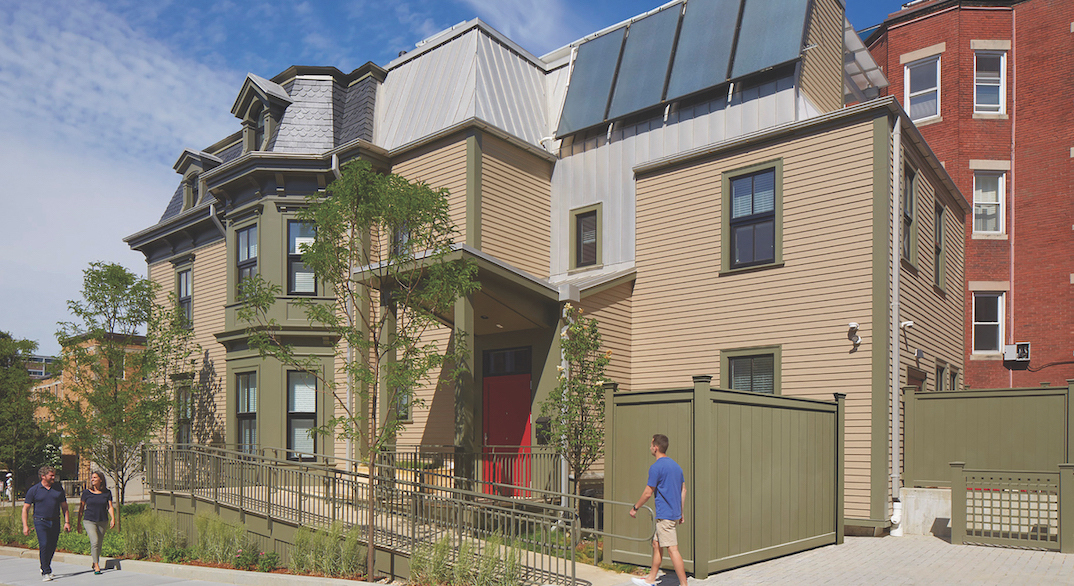Two years ago, Cambridge, Mass., adopted ambitious net-zero energy standards for the construction and renovation of city-owned properties. One of the first projects to fall under this rubric was an 1885 Victorian home at 859 Massachusetts Avenue. The 7,500-sf structure, which was being used as office space, has since been refashioned into a 10-unit shelter for homeless families.
The LEED Gold–certified structure has been operating at “near-net-zero” energy use. Because Cambridge has a strong historic preservation ethos, the project team had to carefully balance energy conservation with the preservation of historical integrity.
The facility replaced a deteriorating structure of similar age and size. “Fortunately, this house was solidly built,” said Lori Cowles, AIA, President of HMFH Architects, the design firm on the project. But its faded aluminum siding, jerry-built front entryway, rusting fire escapes, and paved-over gardens were obvious signs of decline.
The building needed extensive work to be made suitable for modern residential use. The City of Cambridge invested $5 million of city tax dollars in the renovation. “The city believed that the residents deserved a beautiful space,” said Ellen Semonoff, Assistant City Manager, Human Services.
Demolition revealed unexpected structural deficiencies. Floorboards, joists, and sections of flooring were rotted. “The flooring had some hand-hewn boards that were not standard-sized,” said Brendon Roy, Project Manager for the city. “They had to be shimmed or cut down to make them work.” New footings were poured to reinforce the structure. The rubble foundation required extensive patching.
A MAJOR SETBACK, A NEW OPPORTUNITY FOR MULTIFAMILY HOUSING
One of the keys to reaching net zero was to install a geothermal heating/cooling system. But two attempts to drill 900-foot wells on site resulted in nothing but broken drill bits. At this point construction was well under way, so the city decided to drop the geothermal option.
That turned out to be a blessing. The mechanical engineer, Garcia, Galuska & DeSousa, substituted variable refrigerant flow technology with an above-ground air-to-water cooler. “The efficiency on this system turned out to be better than a geothermal well,” said Roy.
A generously insulated, tight envelope was critical to achieving net-zero energy efficiency. The thickness of exterior walls was doubled so that a six-inch layer of continuous mineral wool outboard of the studs could be applied. Four inches of cellulose insulation was blown in between the studs. The interior of the foundation was insulated with 4½ inches of closed-cell spray foam.
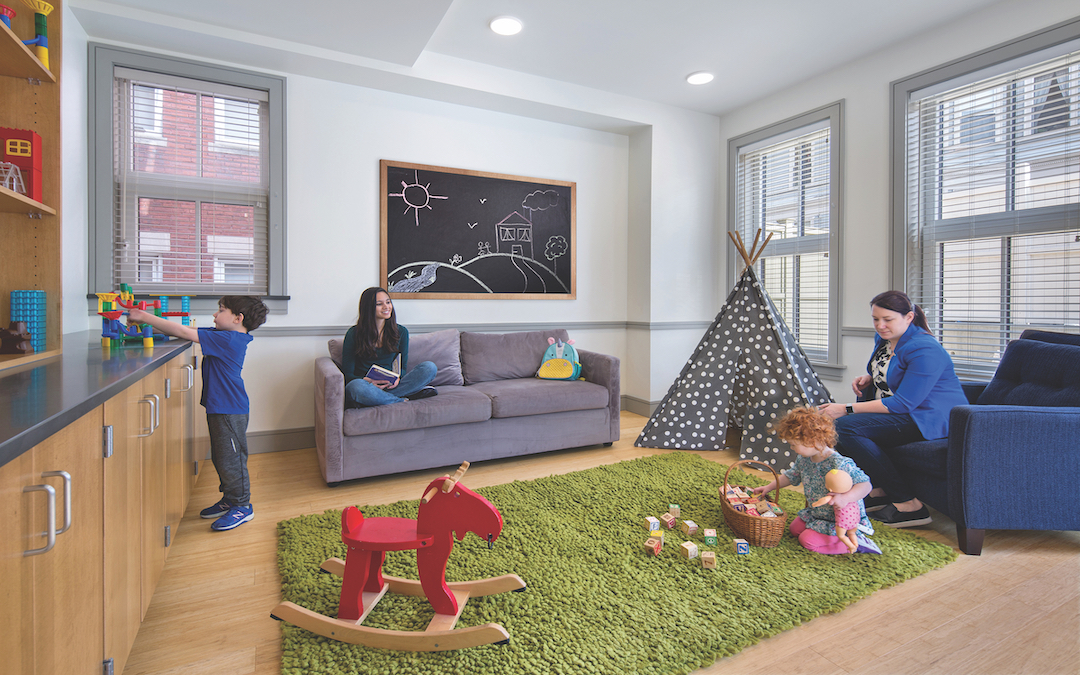 Children share a playroom at Renae’s Place. There’s also a play structure in the backyard. Horizons for Homeless Children hosts a play space weeknights to give parents time to work on job applications and résumés. YWCA Cambridge provides social services and manages the property for the city. Photo: Ed Wonsek
Children share a playroom at Renae’s Place. There’s also a play structure in the backyard. Horizons for Homeless Children hosts a play space weeknights to give parents time to work on job applications and résumés. YWCA Cambridge provides social services and manages the property for the city. Photo: Ed Wonsek
Eight inches of cellulose insulation was blown in between the roof rafters, and five inches of rigid extruded polyisocyanurate was installed under a section of flat roof.
Zola Thermo-Clad doors and windows from Germany, made with aluminum-clad wood and triple-glazed with a low-e coating, yielded an R-7 insulation value. “They are better insulated than any other doors and windows—almost three inches thick,” said Roy. “This was bleeding-edge technology, and because they were sourced from Germany, there were longer lead times. But this was something we needed to do to get to net zero, even if it will take 30 years to pay off.”
Final energy use calculations for the first year were not available at this writing. Based on available data, the structure has a predicted site energy use intensity of 17.02 kBtu/sf/year compared to 59.6 site EUI for a typical multifamily building of this type.
HISTORICAL COMMISSION PROVES FLEXIBLE FOR THIS MULTIFAMILY DEVELOPMENT
The Cambridge Historical Commission, which was involved from the early design stage, was open to accepting less than total historic accuracy in some cases. “Cambridge has a wealth of homes from different time periods,” said Cowles. “This is not a one-of-a-kind for the city.” Even though the imported tilt-turn windows were not historically accurate, the commission acknowledged that their tight-sealing capability was crucial to the success of the net-zero energy scheme.
The commission also approved cellular PVC cornices and trim that looked close enough to the original wood from a distance and would be more durable than wood. After the aluminum siding was removed, new clues were revealed. “We could see ghosts of architectural details,” said Cowles. This shadowing helped in the selection of historically accurate exterior features.
Being true to the original design required extensive detective work. “Many of the buildings on the block from that era were gone,” said Cowles. HMFH designers pored over old photographs of the property to help choose appropriate detail features. “We were lucky that the city’s historical commission keeps good records,” said Cowles.
Built during the late Victorian period, the original structure was not as ornate as those constructed in the high Victorian era, “with all the bells and whistles,” said Cowles. Research showed that bright tones were not available at that time, so a muted tan and green color scheme was chosen.
Putting solar panels on roofs is almost always prohibited in historic building projects, but the project team got lucky. “Due to the shape of the roofline, you can’t see the panels from the street, so we were able to put panels on the roof,” said Cowles. Solar thermal collectors mounted to the roof provide hot water.
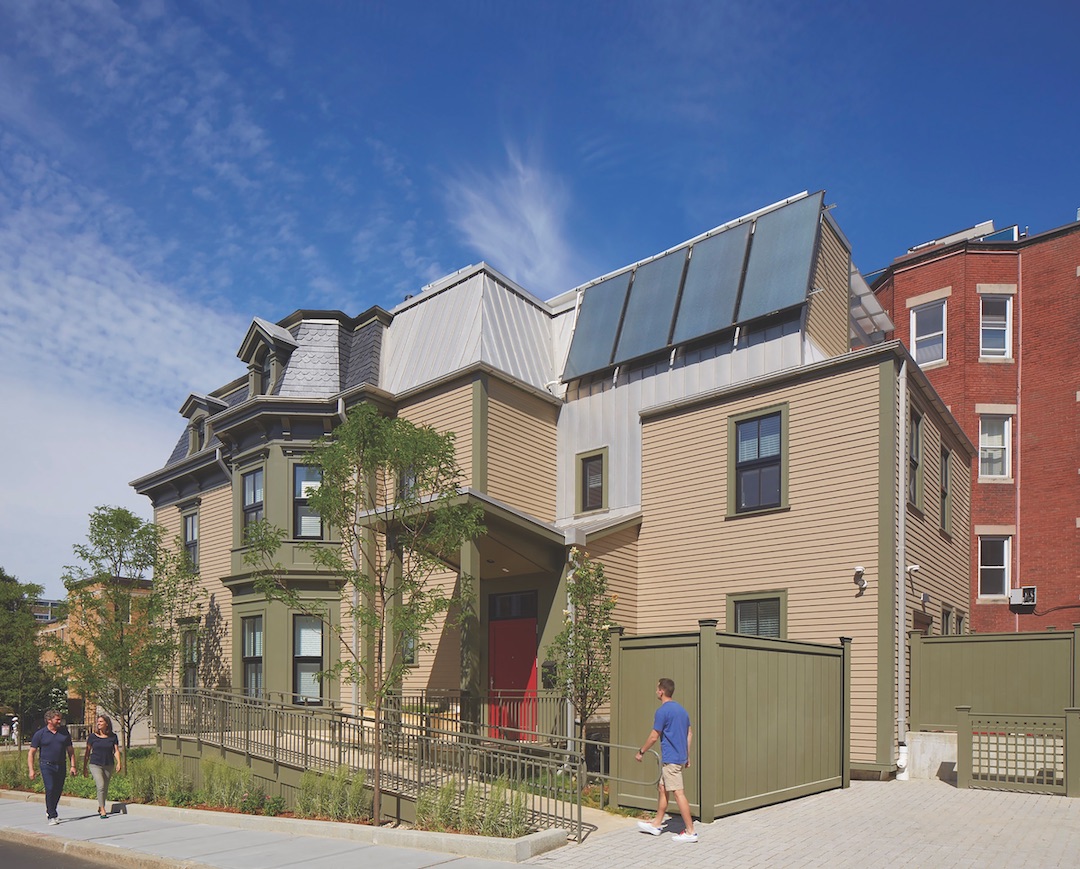 Rather than try to dress up a nonconforming late addition (at right in photo) in Victorian style, designers left it looking pretty much as is and hung photovoltaics at the roof level. PVs on the roof of the original mansion were permitted by the historical commission because they were obscured from street view. Photo: Bruce T. Martin
Rather than try to dress up a nonconforming late addition (at right in photo) in Victorian style, designers left it looking pretty much as is and hung photovoltaics at the roof level. PVs on the roof of the original mansion were permitted by the historical commission because they were obscured from street view. Photo: Bruce T. Martin
The PVs are capable of generating 15.51 KW. But because the local utility does not allow PV systems in this area to export power back to the grid, the property cannot benefit from net metering, and thus does not reap the full benefit of its solar-generating capacity.
The structure probably would have achieved its net-zero goal but for the restriction preventing net metering and the need to put a refrigerator in every unit.
The shelter opened in June 2018. Residents, primarily homeless women and their children, typically spend about 18 months in the facility while they wait for more permanent housing. The upgrades include two units for residents with disabilities.
The units range in size from 220 to 260 sf and can accommodate an adult and one or two children—a tight fit, but better than the alternative. Interiors feature solid surface Caesarstone countertops and LED lighting with sensor technology. There are group kitchens with energy-efficient induction cooktops and dining areas on each floor. Children share a playroom as well as a backyard with a play structure. A private room affords space to case managers from YWCA Cambridge, which manages the building under contract with the city, for confidential meetings with residents about social services.
Aesthetically, the historically reverential restoration is now seen as an asset to the neighborhood instead of a blight. It was named Renae’s Place, for Renae Gray, a longtime activist affiliated with the YWCA. “She died a year before it opened,” said Semonoff. “It embodies her spirit.”
PROJECT TEAM | RENAE’S PLACE
CLIENT City of Cambridge, Mass.
PROPERTY MANAGER YWCA Cambridge
ARCHITECT HMFH Architects
MECHANICAL ENGINEER Garcia, Galuska & DeSousa
GENERAL CONTRACTOR Homer Contracting
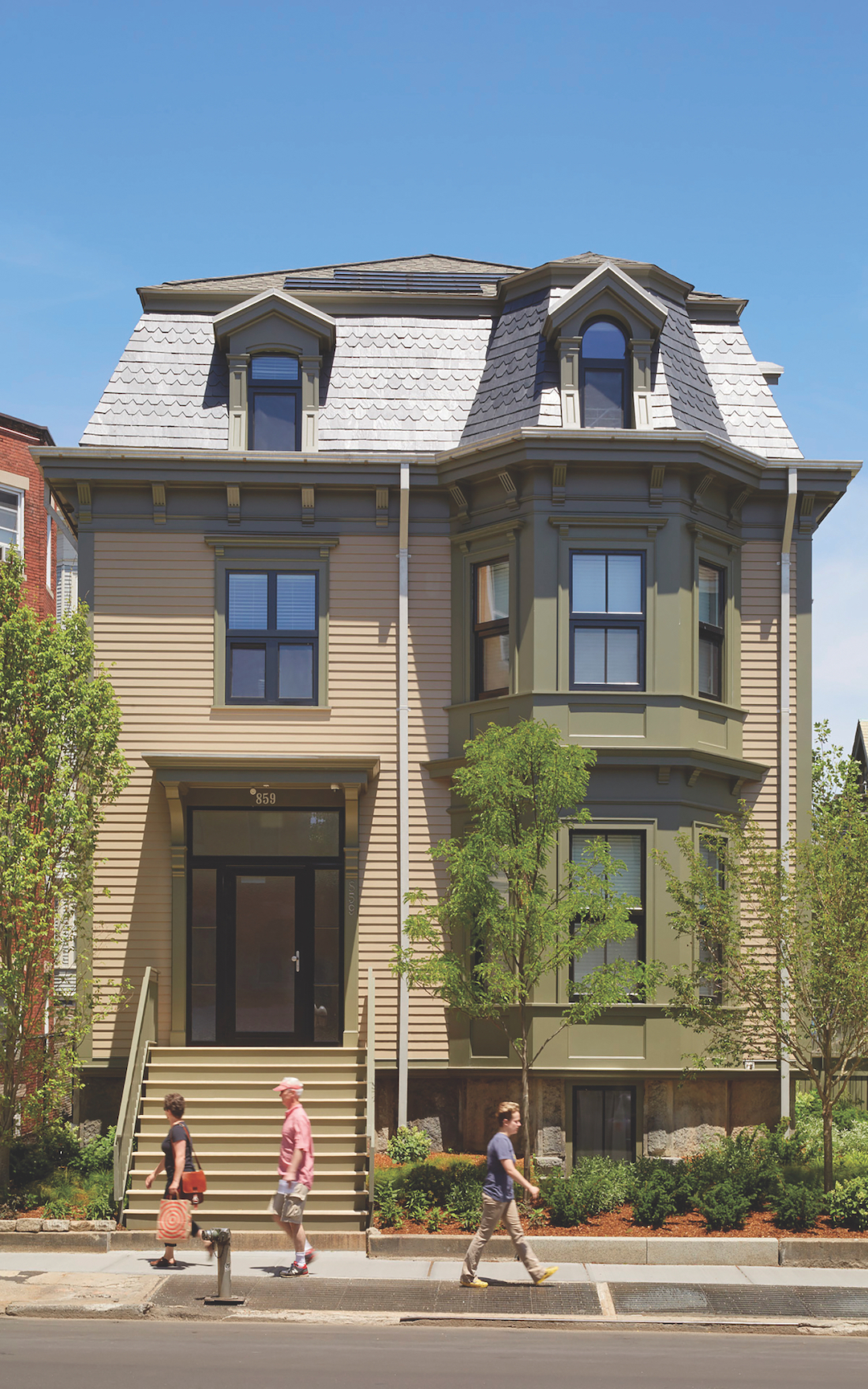 Photo: Bruce T. Martin
Photo: Bruce T. Martin
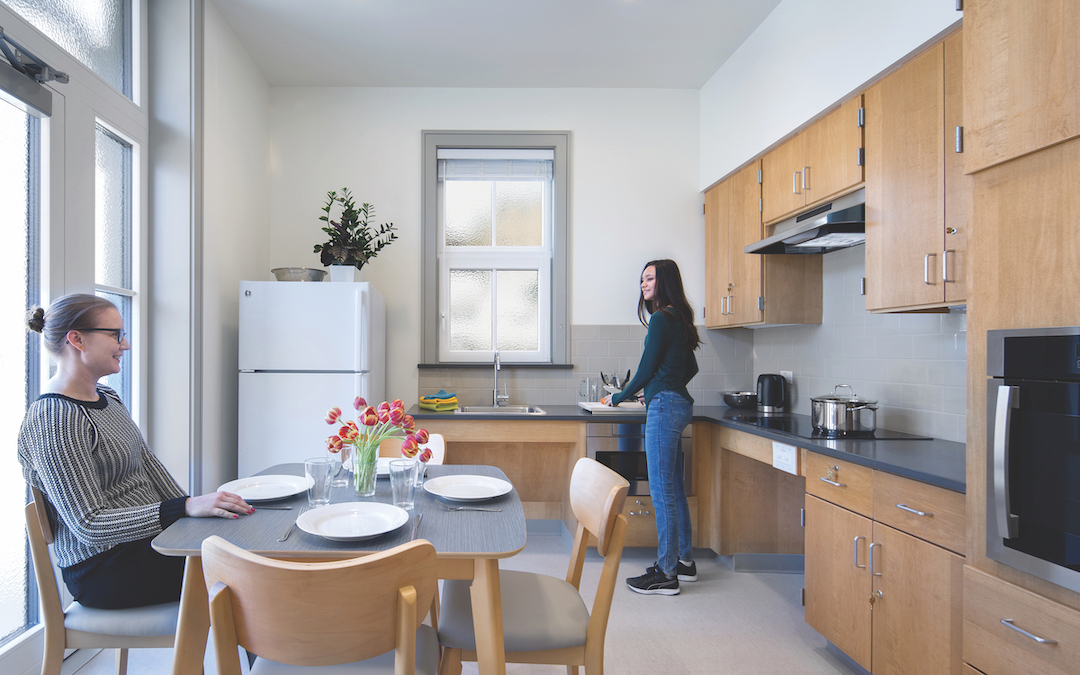 Photo: Ed Wonsek
Photo: Ed Wonsek
Related Stories
| Dec 20, 2013
Can energy hogs still be considered efficient buildings? Yes, say engineers at Buro Happold
A new tool from the engineering firm Buro Happold takes into account both energy and economic performance of buildings for a true measure of efficiency.
| Dec 13, 2013
Safe and sound: 10 solutions for fire and life safety
From a dual fire-CO detector to an aspiration-sensing fire alarm, BD+C editors present a roundup of new fire and life safety products and technologies.
| Dec 10, 2013
16 great solutions for architects, engineers, and contractors
From a crowd-funded smart shovel to a why-didn’t-someone-do-this-sooner scheme for managing traffic in public restrooms, these ideas are noteworthy for creative problem-solving. Here are some of the most intriguing innovations the BD+C community has brought to our attention this year.
| Dec 4, 2013
First look: Dubai's winning bid for World Expo 2020 [slideshow]
Dubai has been chosen as the site of the 2020 World Expo. HOK led the design team that developed the master plan for the Expo, which is expected to draw more than 25 million visitors from October 2020 through April 2021.
| Nov 27, 2013
Exclusive survey: Revenues increased at nearly half of AEC firms in 2013
Forty-six percent of the respondents to an exclusive BD+C survey of AEC professionals reported that revenues had increased this year compared to 2012, with another 24.2% saying cash flow had stayed the same.
| Nov 27, 2013
Wonder walls: 13 choices for the building envelope
BD+C editors present a roundup of the latest technologies and applications in exterior wall systems, from a tapered metal wall installation in Oklahoma to a textured precast concrete solution in North Carolina.
| Nov 26, 2013
Construction costs rise for 22nd straight month in November
Construction costs in North America rose for the 22nd consecutive month in November as labor costs continued to increase, amid growing industry concern over the tight availability of skilled workers.
| Nov 25, 2013
Building Teams need to help owners avoid 'operational stray'
"Operational stray" occurs when a building’s MEP systems don’t work the way they should. Even the most well-designed and constructed building can stray from perfection—and that can cost the owner a ton in unnecessary utility costs. But help is on the way.
| Nov 19, 2013
Top 10 green building products for 2014
Assa Abloy's power-over-ethernet access-control locks and Schüco's retrofit façade system are among the products to make BuildingGreen Inc.'s annual Top-10 Green Building Products list.
| Nov 15, 2013
Greenbuild 2013 Report - BD+C Exclusive
The BD+C editorial team brings you this special report on the latest green building trends across nine key market sectors.


